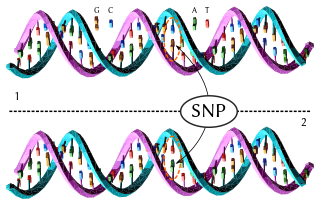A microsatellite is a tract of repetitive DNA in which certain DNA motifs are repeated, typically 5–50 times. Microsatellites occur at thousands of locations within an organism's genome. They have a higher mutation rate than other areas of DNA leading to high genetic diversity. Microsatellites are often referred to as short tandem repeats (STRs) by forensic geneticists and in genetic genealogy, or as simple sequence repeats (SSRs) by plant geneticists.

DNA profiling is the process of determining an individual's DNA characteristics. DNA analysis intended to identify a species, rather than an individual, is called DNA barcoding.
Y-chromosomal Aaron is the name given to the hypothesized most recent common ancestor of the patrilineal Jewish priestly caste known as Kohanim. According to the traditional understanding of the Hebrew Bible, this ancestor was Aaron, the brother of Moses.

A haplotype is a group of alleles in an organism that are inherited together from a single parent.
Forensic identification is the application of forensic science, or "forensics", and technology to identify specific objects from the trace evidence they leave, often at a crime scene or the scene of an accident. Forensic means "for the courts".
A genealogical DNA test is a DNA-based test used in genetic genealogy that looks at specific locations of a person's genome in order to find or verify ancestral genealogical relationships, or to estimate the ethnic mixture of an individual. Since different testing companies use different ethnic reference groups and different matching algorithms, ethnicity estimates for an individual vary between tests, sometimes dramatically.
A Y-STR is a short tandem repeat (STR) on the Y-chromosome. Y-STRs are often used in forensics, paternity, and genealogical DNA testing. Y-STRs are taken specifically from the male Y chromosome. These Y-STRs provide a weaker analysis than autosomal STRs because the Y chromosome is only found in males, which are only passed down by the father, making the Y chromosome in any paternal line practically identical. This causes a significantly smaller amount of distinction between Y-STR samples. Autosomal STRs provide a much stronger analytical power because of the random matching that occurs between pairs of chromosomes during the zygote making process.
In computer programming, code bloat is the production of program code that is perceived as unnecessarily long, slow, or otherwise wasteful of resources. Code bloat can be caused by inadequacies in the programming language in which the code is written, the compiler used to compile it, or the programmer writing it. Thus, while code bloat generally refers to source code size, it can be used to refer instead to the generated code size or even the binary file size.

Haplogroup G (M201) is a human Y-chromosome haplogroup. It is one of two branches of the parent haplogroup GHIJK, the other being HIJK.
Preimplantation genetic haplotyping (PGH) is a clinical method of preimplantation genetic diagnosis (PGD) used to determine the presence of single gene disorders in offspring. PGH provides a more feasible method of gene location than whole-genome association experiments, which are expensive and time-consuming.
A surname DNA project is a genetic genealogy project which uses genealogical DNA tests to trace male lineage.
Short Tandem Repeat (STR) analysis is a common molecular biology method used to compare allele repeats at specific loci in DNA between two or more samples. A short tandem repeat is a microsatellite with repeat units that are 2 to 7 base pairs in length, with the number of repeats varying among individuals, making STRs effective for human identification purposes. This method differs from restriction fragment length polymorphism analysis (RFLP) since STR analysis does not cut the DNA with restriction enzymes. Instead, polymerase chain reaction (PCR) is employed to discover the lengths of the short tandem repeats based on the length of the PCR product.
In genetic genealogy, a unique-event polymorphism (UEP) is a genetic marker that corresponds to a mutation that is likely to occur so infrequently that it is believed overwhelmingly probable that all the individuals who share the marker, worldwide, will have inherited it from the same common ancestor, and the same single mutation event.
The Sorenson Molecular Genealogy Foundation (SMGF) was an independent DNA and genealogical research institution with the goal of demonstrating how the peoples of the world are related. SMGF collected DNA samples and genealogical information from individuals across the globe to establish these connections.

In human genetics, Haplogroup G-M285, also known as Haplogroup G1, is a Y-chromosome haplogroup. Haplogroup G1 is a primary subclade of haplogroup G.
Haplogroup G-FGC7535, also known as Haplogroup G2a1, is a Y-chromosome haplogroup. It is an immediate descendant of G2a (G-P15), which is a primary branch of haplogroup G2 (P287).
In human genetics, Haplogroup G-P303 is a Y-chromosome haplogroup. It is a branch of haplogroup G (Y-DNA) (M201). In descending order, G-P303 is additionally a branch of G2 (P287), G2a (P15), G2a2, G2a2b, G2a2b2, and finally G2a2b2a. This haplogroup represents the majority of haplogroup G men in most areas of Europe west of Russia and the Black Sea. To the east, G-P303 is found among G persons across the Middle East, Iran, the southern Caucasus area, China, and India. G-P303 exhibits its highest diversity in the Levant.
In human genetics, Haplogroup G-M406 is a Y-chromosome haplogroup. G-M406 is a branch of Haplogroup G Y-DNA (M201). More specifically in descending order, G-M406 is a subbranch also of G2 (P287), G2a (P15) and finally G2a2b (L30/S126) Haplogroup G-M406 seems most common in Turkey and Greece. Secondary concentrations of G-M406 are found in the northern and eastern Mediterranean, and it is found in very small numbers in more inland areas of Europe, the Middle East, and the southern Caucasus Mountains area.
In human genetics, Haplogroup G (M201) is a Y-chromosome haplogroup